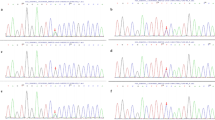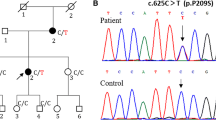Abstract
Background
Charcot-Marie-Tooth disease type 1C (CMT1C) is a rare subtype associated with LITAF gene mutations. Until now, only a few studies have reported the clinical features of CMT1C.
Objective
This study was performed to find CMT1C patients with mutation of LITAF in a Korean CMT cohort and to characterize their clinical features.
Methods
In total, 1,143 unrelated Korean families with CMT were enrolled in a cohort. We performed whole exome sequencing to identify LITAF mutations, and examined clinical phenotypes including electrophysiological and MRI features for the identified CMT1C patients.
Results
We identified 10 CMT1C patients from three unrelated families with p.G112S mutation in LITAF. The frequency of CMT1C among CMT1 patients was 0.59%, which is similar to reports from Western populations. CMT1C patients showed milder symptoms than CMT1A patients. The mean CMT neuropathy score version 2 was 7.7, and the mean functional disability scale was 1.0. Electrophysiological findings showed a conduction block in 22% of affected individuals. Lower extremity MRIs showed that the superficial posterior and anterolateral compartments of the calf were predominantly affected.
Conclusions
We found a conduction block in Korean CMT1C patients with p.G112S mutation and first described the characteristic MRI findings of the lower extremities in patients with LITAF mutation. These findings will be helpful for genotype–phenotype correlation and will widen understanding about the clinical spectrum of CMT1C.




Similar content being viewed by others
Availability of data and materials
All raw genetic and clinical data generated or analyzed during this study are available upon request to the corresponding author.
References
Bennett CL, Shirk AJ, Huynh HM, Street VA, Nelis E, Van Maldergem L, De Jonghe P, Jordanova A, Guergueltcheva V, Tournev I, Van den Bergh P, Seeman P, Mazanec R, Prochazka T, Kremensky I, Haberlova J, Weiss MD, Timmerman V, Bird TD, Chance PF (2004) SIMPLE mutation in demyelinating neuropathy and distribution in sciatic nerve. Ann Neurol 55:713–720. https://doi.org/10.1002/ana.20094
Ciotti P, Luigetti M, Geroldi A, Capponi S, Pezzini I, Gulli R, Pazzaglia C, Padua L, Massa R, Mandich P et al (2014) A novel LITAF/SIMPLE mutation within a family with a demyelinating form of Charcot-Marie-Tooth disease. J Neurol Sci 343:183–186
Cornett KMD, Wojciechowski E, Sman AD, Walker T, Menezes MP, Bray P, Halaki M, Burns J, Group FS (2019) Magnetic resonance imaging of the anterior compartment of the lower leg is a biomarker for weakness, disability, and impaired gait in childhood Charcot-Marie-Tooth disease. Muscle Nerve 59:213–217
Dahlqvist JR, Widholm P, Leinhard OD, Vissing J (2020) MRI in neuromuscular diseases: an emerging diagnostic tool and biomarker for prognosis and efficacy. Ann Neurol 88:669–681
Gallardo E, Garcia A, Combarros O, Berciano J (2006) Charcot-Marie-Tooth disease type 1A duplication: spectrum of clinical and magnetic resonance imaging features in leg and foot muscles. Brain 129:426–437
Gentile L, Russo M, Fabrizi GM, Taioli F, Ferrarini M, Testi S, Alfonzo A, Aguennouz M, Toscano A, Vita G, Mazzeo A (2020) Charcot-Marie-Tooth disease: experience from a large Italian tertiary neuromuscular center. Neurol Sci 41:1239–1243
Goutallier D, Postel JM, Bernageau J, Lavau L, Voisin MC (1994) Fatty muscle degeneration in cuff ruptures. Pre- and postoperative evaluation by CT scan. Clin Orthop Relat Res 304:78–83
Guimaraes-Costa R, Iancu Ferfoglia R, Leonard-Louis S, Ziegler F, Magy L, Fournier E, Dubourg O, Bouche P, Maisonobe T, Lacour A et al (2017) Phenotypic spectrum of Charcot-Marie-Tooth disease due to LITAF/SIMPLE mutations: a study of 18 patients. Eur J Neurol 24:530–538
Jerath NU, Shy ME (2017) Charcot-Marie-Tooth disease type 1C: clinical and electrophysiological findings for the c.334G>a (p.Gly112Ser) Litaf/Simple mutation. Muscle Nerve 56:1092–1095
Kanwal S, Choi YJ, Lim SO, Choi HJ, Park JH, Nuzhat R, Khan A, Perveen S, Choi BO, Chung KW (2021) Novel homozygous mutations in Pakistani families with Charcot-Marie-Tooth disease. BMC Med Genomics 14:174
Lacerda AF, Hartjes E, Brunetti CR (2014) LITAF mutations associated with Charcot-Marie-Tooth disease 1C show mislocalization from the late endosome/lysosome to the mitochondria. PLoS One 9:e103454
Latour P, Gonnaud PM, Ollagnon E, Chan V, Perelman S, Stojkovic T, Stoll C, Vial C, Ziegler F, Vandenberghe A et al (2006) SIMPLE mutation analysis in dominant demyelinating Charcot-Marie-Tooth disease: three novel mutations. J Peripher Nerv Syst 11:148–155
Lee SM, Olzmann JA, Chin LS, Li L (2011) Mutations associated with Charcot-Marie-Tooth disease cause SIMPLE protein mislocalization and degradation by the proteasome and aggresome-autophagy pathways. J Cell Sci 124:3319–3331
Lee SM, Chin LS, Li L (2012) Charcot-Marie-Tooth disease-linked protein SIMPLE functions with the ESCRT machinery in endosomal trafficking. J Cell Biol 199:799–816
Lee SM, Sha D, Mohammed AA, Asress S, Glass JD, Chin LS, Li L (2013) Motor and sensory neuropathy due to myelin infolding and paranodal damage in a transgenic mouse model of Charcot-Marie-Tooth disease type 1C. Hum Mol Genet 22:1755–1770
Lewis RA, Sumner AJ, Shy ME (2000) Electrophysiological features of inherited demyelinating neuropathies: a reappraisal in the era of molecular diagnosis. Muscle Nerve 23:1472–1487
Li W, Zhu H, Zhao X, Brancho D, Liang Y, Zou Y, Bennett C, Chow CW (2015) Dysregulated inflammatory signaling upon Charcot-Marie-Tooth Type 1C mutation of SIMPLE protein. Mol Cell Biol 35:2464–2478
Merrill JC, You J, Constable C, Leeman SE, Amar S (2011) Whole-body deletion of LPS-induced TNF-alpha factor (LITAF) markedly improves experimental endotoxic shock and inflammatory arthritis. Proc Natl Acad Sci USA 108:21247–21252
Morrow JM, Sinclair CD, Fischmann A, Machado PM, Reilly MM, Yousry TA, Thornton JS, Hanna MG (2016) MRI biomarker assessment of neuromuscular disease progression: a prospective observational cohort study. Lancet Neurol 15:65–77
Murphy SM, Herrmann DN, McDermott MP, Scherer SS, Shy ME, Reilly MM, Pareyson D (2011) Reliability of the CMT neuropathy score (second version) in Charcot-Marie-Tooth disease. J Peripher Nerv Syst 16:191–198
Murphy SM, Laura M, Fawcett K, Pandraud A, Liu YT, Davidson GL, Rossor AM, Polke JM, Castleman V, Manji H et al (2012) Charcot-Marie-Tooth disease: frequency of genetic subtypes and guidelines for genetic testing. J Neurol Neurosurg Psychiatry 83:706–710
Pareyson D, Scaioli V, Laura M (2006) Clinical and electrophysiological aspects of Charcot-Marie-Tooth disease. Neuromolecular Med 8:3–22
Paternostro-Sluga T, Grim-Stieger M, Posch M, Schuhfried O, Vacariu G, Mittermaier C, Bittner C, Fialka-Moser V (2008) Reliability and validity of the Medical Research Council (MRC) scale and a modified scale for testing muscle strength in patients with radial palsy. J Rehabil Med 40:665–671
Pelayo-Negro AL, Gallardo E, Garcia A, Sanchez-Juan P, Infante J, Berciano J (2014) Evolution of Charcot-Marie-Tooth disease type 1A duplication: a 2-year clinico-electrophysiological and lower-limb muscle MRI longitudinal study. J Neurol 261:675–685
Rossor AM, Polke JM, Houlden H, Reilly MM (2013) Clinical implications of genetic advances in Charcot-Marie-Tooth disease. Nat Rev Neurol 9:562–571
Somandin C, Gerber D, Pereira JA, Horn M, Suter U (2012) LITAF (SIMPLE) regulates Wallerian degeneration after injury but is not essential for peripheral nerve development and maintenance: implications for Charcot-Marie-Tooth disease. Glia 60:1518–1528
Timmerman V, Strickland AV, Zuchner S (2014) Genetics of Charcot-Marie-Tooth (CMT) disease within the frame of the human genome project success. Genes (basel) 5:13–32
Van den Bergh PY, Hadden RD, Bouche P, Cornblath DR, Hahn A, Illa I, Koski CL, Léger JM, Nobile-Orazio E, van Schaik IN et al (2010) European Federation of Neurological Societies/Peripheral Nerve Society guideline on management of chronic inflammatory demyelinating polyradiculoneuropathy: report of a joint task force of the European Federation of Neurological Societies and the Peripheral Nerve Society—first revision. Eur J Neurol 17:356–363
Zhu H, Guariglia S, Yu RY, Li W, Brancho D, Peinado H, Lyden D, Salzer J, Bennett C, Chow CW (2013) Mutation of SIMPLE in Charcot-Marie-Tooth 1C alters production of exosomes. Mol Biol Cell 24(1619–1637):s1611-1613
Acknowledgements
This work was supported by grants from the National Research Foundation (2019R1A2C1087547, 2020M3H4A1A03084600, and 2021R1A4A2001389) and the Korean Health Technology R&D Project, Ministry of Health and Welfare (HI14C3484 and HI20C0039), Republic of Korea.
Author information
Authors and Affiliations
Contributions
B-OC and KWC planned and supervised this study. NYJ, AJL, and SHN performed the molecular genetic work. HMK. JK, and JP performed the clinical and neuroimaging work. NYJ, AJL, and KWC interpreted genetic data and conducted the statistical analyses. B-OC collected the participant samples and information. JP, HMK, B-OC, and KWC wrote the manuscript. All the co‑authors read and approved the final version of the manuscript.
Corresponding authors
Ethics declarations
Competing interests
The authors have no competing interests to declare.
Ethics approval and consent to participate
This study was approved by the Institutional Review Boards of Sungkyunkwan University, Samsung Medical Center (2014–08-057–002), and Kongju National University (KNU-IRB-2018–62). Written informed consent was obtained from all participants.
Patient consent for publication
Not applicable.
Additional information
Publisher's Note
Springer Nature remains neutral with regard to jurisdictional claims in published maps and institutional affiliations.
Supplementary Information
Below is the link to the electronic supplementary material.
Rights and permissions
About this article
Cite this article
Park, J., Kim, H.S., Kwon, H.M. et al. Identification and clinical characterization of Charcot-Marie-Tooth disease type 1C patients with LITAF p.G112S mutation. Genes Genom 44, 1007–1016 (2022). https://doi.org/10.1007/s13258-022-01253-w
Received:
Accepted:
Published:
Issue Date:
DOI: https://doi.org/10.1007/s13258-022-01253-w




